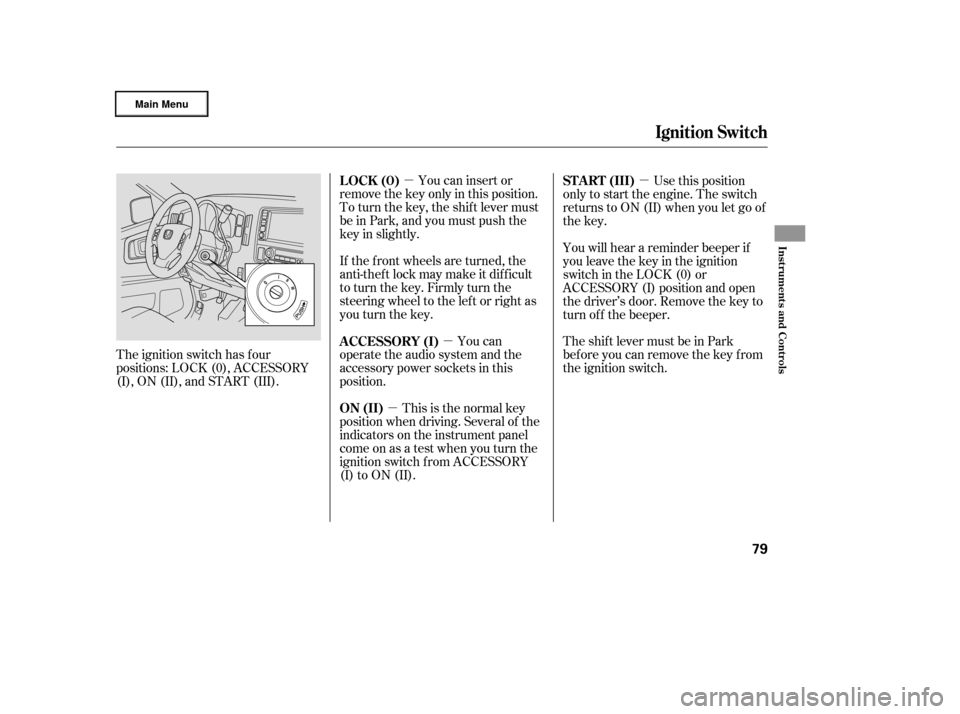Page 74 of 320
�Î
�Î
�Î
�Î
�Î
�Î To use the horn, press the pad around the ‘‘H’’ logo.
If equipped.
1:
2:
Controls Near the Steering Wheel
Inst rument s and Cont rols
71
HAZARD WARNING
BUTTON
(P.76)
SHIFT LEVER
VEHICLE STABILITY
ASSIST SYSTEM
OFF SWITCH
CRUISE BUTTON
CRUISE
CONTROLS
HORN
STEERING WHEEL
ADJUSTMENT VTM-4LOCK
Vehicle with navigation system is shown. BED LIGHT SWITCH MULTI-CONTROL LEVER
(WINDSHIELD WIPERS/
WASHERS/TURN SIGNALS/
HEADLIGHT HIGH BEAMS)
MOONROOF SWITCH
SEAT HEATERS
INTERIOR LIGHT
CONTROL SWITCH
(P.105)
(P.72) (P.117)
(P.206)
(P.163)
(P.159) (P.76)(P.163)
(P.115)
INSTRUMENT PANEL
BRIGHTNESS
(P.75)
(P.193) (P.198)
(P.101)
HEADLIGHT CONTROL
DIAL
(P.73) RESET BUTTON
SELECT BUTTON (P.67)
(P.67)
REMOTE AUDIO
CONTROLS
1
2
2
2
�����—�����—�����y�
����
����
���y���
�(�����������y���������y
Page 79 of 320

Push the lever up to lock the
steering wheel in position.
Make sure you have securely
locked the steering wheel in place
by trying to move it up and down.
Make any steering wheel adjustment
bef ore you start driving.
Pushtheredbuttontoturnonthe
hazard warning lights (f our-way
flashers). This causes all four
outside turn signals and both turn
indicators in the instrument panel to
f lash. Use the hazard warning lights
if you need to park in a dangerous
area near heavy traffic, or if your
vehicle is disabled. Move the steering wheel so it
points toward your chest, not
toward your f ace. Make sure you
can see the instrument panel
gauges and indicators. Push the lever on the lef t side of
the steering column all the way
down.3.
4.
1.
2.
Hazard Warning Button, Steering Wheel A djustment
Steering Wheel A djustment
Hazard Warning Button
76
Adjusting the steering wheel
position while driving may
cause you to lose control of the
vehicle and be seriously injured
inacrash.
Adjust the steering wheel only
when the vehicle is stopped.
�����—�
���—�����y�
�������������y���
�(�����������y�������
�y
Page 82 of 320

�µ�µ
�µ �µ
The ignition switch has f our
positions: LOCK (0), ACCESSORY
(I), ON (II), and START (III). You can insert or
remove the key only in this position.
To turn the key, the shift lever must
be in Park, and you must push the
key in slightly.
If the f ront wheels are turned, the
anti-theft lock may make it difficult
to turn the key. Firmly turn the
steering wheel to the lef t or right as
you turn the key.
You can
operate the audio system and the
accessory power sockets in this
position.
This is the normal key
position when driving. Several of the
indicators on the instrument panel
come on as a test when you turn the
ignition switch f rom ACCESSORY
(I) to ON (II). Use this position
only to start the engine. The switch
returns to ON (II) when you let go of
the key.
You will hear a reminder beeper if
you leave the key in the ignition
switch in the LOCK (0) or
ACCESSORY (I) position and open
the driver’s door. Remove the key to
turn of f the beeper.
TheshiftlevermustbeinPark
bef ore you can remove the key f rom
the ignition switch.
LOCK (0)
A CCESSORY (I)
ON (II) ST A RT (III)
Ignition Switch
Inst rument s and Cont rols
79
�����—�
���—�����y�
�������������y���
�(�����������y���������y
Page 133 of 320
Theclimatecontrolsystemhastwo
sensors. A sunlight sensor is in the
top of the dashboard, and a
temperature sensor is under the
steering column. Do not cover the
sensors or spill any liquid on them.
On RTS, RTL, and Canadian EXLmodels
Climat e Cont rol Sensors
Sunlight and T emperature
Sensors
130
SUNLIGHT SENSOR TEMPERATURE SENSOR
�����—�
���—�����y�
�������������y���
�(�����������y���
�����y
Page 162 of 320

�Û�Ý�Û
�Ý
�Û �Ý
The VOL button adjusts the volume
up ( ) or down ( ). Press the top
or bottom of the button, hold it until
the desired volume is reached, then
release it. Three controls f or the audio system
are mounted in the steering wheel
hub. They let you control basic
f unctions without removing your
hand f rom the steering wheel. The MODE button changes the
mode. Pressing the button
repeatedly selects FM1, FM2, AM,
XM Radio (U.S. models), CD (if a
disc is loaded) or a tape (if the
optional tape player is installed and a
tape is loaded).
If you are listening to the radio, use
the CH button to change stations.
Each time you press the top ( ) of
the button, the system goes to the
next preset station on the band you
are listening to. Press the bottom
( ) to go back to the previous
station.
If youareplayingaCD,thesystem
skips to the beginning of the next
track each time you press the top
( ) of the CH button. Press the
bottom ( ) to return to the
beginning of the current track. Press
it again to return to the previous
track. You will see the disc and track
numbers in the display.
When the appropriate audio unit is
connected to the auxiliary input jack,
press the CD/AUX or AUX button to
select the unit. The auxiliary input jack is on the tray
above the glove box. The system will
accept auxiliary input f rom standard
audio accessories.
On RTS, RTL, and Canadian EXL
models On vehicles with navigation system
Auxiliary Input Jack
Remote A udio Controls, Playing an Optional A udio Unit
Features
159
MODE BUTTON
VOL BUTTON
CH BUTTON AUXILIARY
INPUT JACK
�����—�
���—�����y�
������
������y���
�(�����������y���
�����y
Page 166 of 320
Cruise control allows you to maintain
asetspeedabove25mph(40km/h)
without keeping your f oot on the
accelerator pedal. It should be used
f or cruising on straight, open
highways. It is not recommended f or
city driving, winding roads, slippery
roads, heavy rain, or bad weather.Press and release the SET/
DECELbuttononthesteering
wheel. The indicator on the
instrument panel comes on to
show the system is now activated.
Push the CRUISE button. The
indicator in the button will come
on.
Accelerate to the desired cruising
speedabove25mph(40km/h).
1.
2.
3.
CONT INUED
Using the Cruise Control
Cruise Control
Features
163
CRUISE
BUTTONRES/ACCEL BUTTON
CANCEL
BUTTON
SET/DECEL
BUTTONImproper use of the cruise
control can lead to a crash.
Use the cruise control only
when traveling on open
highways in good weather.
�����—�
���—�����y�
�����������
�y���
�(�����������y���
�����y
Page 168 of 320

When you push the CANCEL button
or tap on the brake pedal, the system
will remember the previously set
cruising speed. To return to that
speed, accelerate to above 25 mph
(40 km/h) and then press and
release the RES/ACCEL button. The
CRUISE CONTROL indicator comes
on. The vehicle will accelerate to the
same cruising speed as bef ore.
Pressing the CRUISE button turns
the system off and erases the
previous cruising speed.
You can cancel cruise control in any
of these ways:
Tap the brake pedal.
Push the CANCEL button on the
steering wheel.
Push the CRUISE button on the
dashboard.
Resting your f oot on the brake pedal
causes cruise control to cancel. Even with cruise control turned on,
you can still use the accelerator
pedal to speed up f or passing. Af ter
completing the pass, take your foot
of f the accelerator pedal. The vehicle
will return to the set cruising speed. Resuming the Set Speed
Cancelling Cruise Control
Cruise Control
Features
165
�����—�
���—�����y�
�������������y���
�(�����������y���
�����y
Page 184 of 320

Larger or smaller wheels and tires
can interf ere with the operation of
your vehicle’s anti-lock brakes and
other systems.
Modif ying your steering wheel or
any other part of your vehicle’s
saf ety systems could make the
systems inef f ective.
If you plan to modif y your vehicle,
consult your dealer.
Removing parts f rom your vehicle,
or replacing components with
non-Honda components could
seriously af f ect your vehicle’s
handling, stability, and reliability.
Some examples are:
Lowering the vehicle with a non-
Honda suspension kit that
signif icantly reduces ground
clearance can allow the
undercarriage to hit speed bumps
or other raised objects, which
could cause the airbags to deploy.
Raising your vehicle with a
non-Honda suspension kit can
af f ect the handling and stability.
Non-Honda wheels, because they
are a universal design, can cause
excessive stress on suspension
components and will not be
compatible with the tire pressure
monitoring system.
Bef ore installing any electronic
accessory, have the installer
contact your dealer f or assistance.
If possible, have your dealer
inspect the f inal installation.
Do not install accessories on the
side pillars or across the rear
windows. In these areas,
accessories may interf ere with
proper operation of the side
curtain airbags.
A ccessories and Modif ications
Modif ying Your Vehicle
Bef ore Driving
181
�����—�
���—�����y�
�������������y���
�(�����������y���
�����y